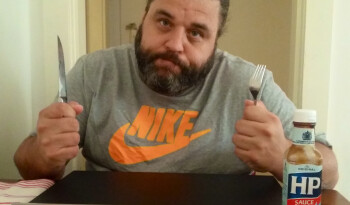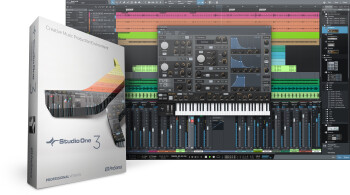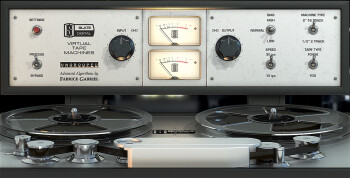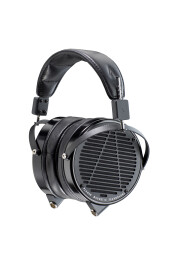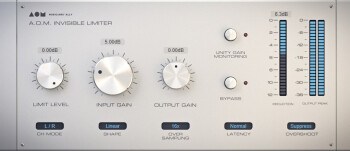“I've always mixed people's records,” Klaus Hill says, “it's just something I've always been very good at.” In the eleven years since he moved from England, Hill has established himself as one of the top mixing and mastering engineers on the Australian dance music scene.
When he first got to Sydney, he was producing his own music. “I had a very successful career making breakbeat, drum & bass, and house music, ” he says, “and then you start getting older and you don’t want to DJ anymore.”
Hill now has a well appointed studio featuring a mastering room, a console-based mixing room, and a portable mixing rig, which he ends up using more often than not, even when he’s in his studio. Housed in a rack case, the rig is highlighted by a Metric Halo 2882 audio interface, a Dangerous D-Box summing mixer and monitor controller, and a Manley Massive Passive equalizer and an A-Designs Hammer EQ.
Audiofanzine had a chance to speak to Hill recently about his hybrid analog/digital studio setup, his opinion of some of the major DAWs on the market, among other subjects.
Talk about the mixing you do.
I basically mix all the records for so many acts. My clients range from Grammy-nominated acts and top U.K.producers to up-and-coming artists. Number ones in about 17 countries. Dance music.
The term “EDM” is thought of differently outside of the U.S.?
In Europe we use that term to describe dance music as a whole, and it’s a term that no one ever really liked. But in America they’ve kind of cottoned onto that, and it’s become a sound over there. This is the third time that America has kind of jumped onto the dance music thing.
It’s certainly gotten big in the U.S. in recent years.
In the last four years, it really picked up again. And that’s been healthy for everybody involved in the music, because at the end of the day it’s a great place to work in, and so many of my clients come from the U.S. It makes a big difference when you have a country like that. There are so many shows and interests. I have a lot of clients coming from the U.S. now, for mixing and stuff. The process is basically, most of the tracks are in a pretty good state. We have a saying in Australia, “You can’t polish a turd, but you can rub it in glitter.” There’s a fair bit of that. But there’s also, as I said, some pretty well established acts. I get the stems sent to me, and I work on a hybrid system: DAW either Logic or Pro Tools. I can’t make my mind up. I’m actually thinking of swapping to Studio One, at the moment. It’s probably the most grounded DAW out there. It’s amazing. I literally just emailed someone this morning because I own Pro Tools, I own Logic, I tried Cubase 8 recently, but I’ve never been able to get on with Cubase. So I’m looking at Studio One. You can fit the new features on Pro Tools 12 on the back of a postage stamp.
It’s ridiculous. It’s an upgrade only to change the pricing structure, really.
And now on Apple computers, you can’t put an SSD drive in yourself, you can’t put RAM in yourself. Everything’s soldered to motherboards. Suddenly, if you want to buy an upgrade, you’ve got to spend $3,000 or $4,000 dollars to get anything for pro audio, unless you build a Hackintosh. I’m swapping over to PC, as well.
I’m kind of surprised to hear about someone using analog summing for dance music, which is so digital sounding.
There’s a lot of dance music guys that use analog summing. A lot of the drum & bass guys. A lot of these guys are using vintage desks. The problem is, in the U.S., there’s only a certain sound that’s being pushed in dance music, which is what they call EDM. It’s really high energy and noisy, with the RMS being pushed to stupid levels. And I’ve worked on stuff like that for some people, so don’t get me wrong. But there’s whole subgenres and different styles where people take pride in their work. And a lot of those guys are all using summing mixing.
What does analog summing do for you sonically?
For me, I get separation, it improves the stereo image, for a start. The separation in the stems is amazing — just between drums and bottom end. Putting it through the summing mixer allows better separation, and allows me to get a better contrast between the kick and the bass, which is what it’s all about. Running them into separate channels gives me more room to work with those. It allows me to fit that area. When people ask, I describe mixing as buidling a sandwich or a painting — the layers. There’s only room for so much stuff. But the D-Box is great for that. Also, it can be pushed so hard, and it’s just a really nice rounded sound to the bottom end, and it takes off a little bit of that digital harshness in the top end as well. Inside the box you get that top end harshness, and the D-Box gets rid of that. But then the rest of the chain helps with that, as well, the analog chain. I’m a big fan of summing mixing. In fact in my studio, I use the D-Box more, but I’ve got an SSL desk there, as well. I don’t use it much because the workflow is not quick enough these days.
Talk more about your portable setup.
I’ve got a Tango controller, digital screen controller that I use, but I’m looking at that new Slate touch screen. But it’s [only] Pro Tools and Logic, so while I’m still debating the DAW “problem, ” I’m not going to go out and spend any more money. Touch screen controller, summing mixer, and I can work super quick. I can recall stuff really quickly. I mean you can recall stuff on the SSL, but it’s just a pain in the ass, to be honest. A stereo channel on the summing mix is the bass, another brings the drums. The vocals have their own channel. Synth parts in another one. So they’re grouped by type running out to the summing mixer. Manley Massive Passive as well in that chain. I’ve got the mastering edition in the mastering room, but I hardly every use it. This rig is all inside a flight case, so it’s a mobile rig. If I go off abroad, or to the US, I can take it and setup anywhere. So I end up using the Manley for mastering, but I don’t have the steeped knobs on it, it’s just a standard one. Whereas in the mastering room, they did the extra work on it. But again, it’s a bit of a waste, because I end up using my mobile setup most of the time.
There are lots of summing mixers out there, what made you choose the D-Box?
I’ve had all the summing mixers, I’ve been across everything. That one’s the most feature packed, great sound, good value for the money. As I said, I can buy stuff that I want, but I just like stuff that’s functional, because I work quickly. I might mix two or three or four tunes in a day. I know some of these rock guys mix whole albums in a day, but with dance stuff, everything’s online, backwards and forwards. Nobody is ever in the studio with you. So to get through that amount of work, it’s hard, especially when you have to Skype with people. I use Splice [an online file saving and collaboration program for recording musicians], so people can see arrangements and whatever else. If I’m working in Logic, I’ll put the files up to Splice, and people can make notes really quickly. It’s a great thing. If not, for Pro Tools and stuff you can use Gobbler.
Why are you thinking of switching DAWs?
Pro Tools 11 has been buggy as shit. As for Logic, they dumbed it down, which was stupid for Apple. I don’t know why, they went for that GarageBand look and everything. But that last update, where they changed the compressor and everything, it’s really good. It’s really stable, and I don’t have any of the issues that I have with Pro Tools, freezing and buggy stuff and everything else. And, as I said, with Splice, it allows me to put the project up, and let people see the arrangement, what’s been used, make notes in it, it makes it really quick. I’ve got all these balancing acts. I’m talking about swapping to Studio One, but then Splice helped my workflow so much. It’s the usual engineer’s dilemma: there’s so much gear, and you’ve got to find what works for you.
You’ve got a lot of hardware, but what about plug-ins?
I’m a massive fan of the Slate stuff. So I think the Slate Virtual Tape Machines is the best tape emulation there is. I use UAD stuff, I love UAD stuff, it’s great, but the tape machines don’t touch the Slate. Personally, for me. So I’ve got a couple of presets I made myself that I use on everything. I put the floor noise all the way down to 0. There’s no point. With the saturation it’s adding to the sound, you don’t need that noise in the digital domain. So I always turn that down. The other thing I do, the plug-in, adds quite a bit of bottom end, so I’ll take a bit of the bass down.
Do you put it on individual channels?
Yeah. It gives a really nice character. I love what Slate does. They make amazing plug-ins.
Have you used the Virtual Mix Rack?
Yes, it’s very good. But my go-to channel strip is the Metric-Halo Channel Strip. That is unbelievable. For EQs, for general channel compression, it just works so well. And it’s an amazing amazing sound. It smacks the drums so hard. It works really nice on snares. I don’t group drums together too much. So I’ll process the kick drum, and I’ll use parallel compression, just loads of it. So I’ll process the kick and I’ll parallel compress it. I’ll process the snare on its own, and I’ll do the same thing for it. I hardly every group anything together on a bus and then compress. But I use the Metric Halo channel strip all the time. The Slate stuff. I’ve been playing around, since they moved it to the Virtual Mix Rack, with the [Virtual] Console. Going out to the summing mixer and stuff, I don’t really need it. But to be honest, it sounds good, but you know what for me sounds better when you go through that, TriTone Colortone. If you want to add that character stuff. TriTone ColorTone, the convolution thing. You put the audio inside it. So if you want to simulate the desk, they put a signal through the desk and it records the character, just like the convolution reverbs. That sounds better to me. I’ve got hundreds of settings for that, SSLs and whatevers, and I just drop that on a channel, and I get quicker results than the Slate.
What about reverb? What’s your favorite?
I still think for halls and that kind of stuff, it’s hard to beat IK Multimedia Classik Studio Reverb — inside the computer. And I’ve had this discussion with a few people over here. Some good engineers over here. And we’ve all kind of come to that conclusion that it’s still a really good reverb.
What others?
BreVerb is another one. BreVerb is amazing The Lexicon stuff is alright, as well. I like the Eventide plug-in. I’ve got the hardware Eventide, it’s I think the 8000. I just don’t drag it around with me. If you want something more digital and a bit weirder: Audio Damage Eos is awesome. And they make really good plug-in at a sensible price. I love all that Audio Damage stuff.
I always wondered about dance music mixers’ monitoring setups. You must have some pretty hefty monitors or subs or something to reproduce that bottom end the way it will be heard in the clubs.
I use PMC. The iBs. They’re about $20,000, $24,000, something like that.
Whoa! Do they have a sub?
Yeah. I love PMCs. But I also use Focals. I probably spend more time on the Focals than on the PMCs. Because there’s no point mixing at loud volumes all the time. But the other thing is that I spend more time on my Audese LCD-X headphones. It’s like strapping a pair of ATCs or PMCs on your ears. They’re made in the U.S. It’s a little company. Everything’s made there. They’re audiophile headphones. They sell them in Harrads in the UK. They’re like $2,000 for headphones. And I was very skeptical. But these things are mind blowing, mate. If I was starting out writing music now, and I was going to update my speakers and that kind of stuff, I wouldn’t. I’d go out and buy a pair of LCD-X’s, and I wouldn’t even bother buying monitors.
What is about them that makes them worth all that money?
You can hear every detail. I can hear every little bit of phasing that’s going on inside that I can’t even hear when I put my big speakers on. They’re just incredible, incredible headphones. And the Focal headphones are really good, as well. The Focal Spirit Professionals. A lot of the dance music stuff is produced in bedroom studios. Nowadays you don’t need to be in big studios. I know kind that are out there making $10,000–12,000 a set DJing, and they make stuff on headphones on a laptop in a hotel when they’re touring. And it’s released.
Without being mastered?
It will be sent to me for mastering, and stuff like that. But a lot of them might just stick a limiter on it and it will go out like that.
I’m not an expert in this kind of music, but if you were only listening on headphones, wouldn’t you be worried what the bass is going to sound like when it’s in the club?
You know, the benefit of that, because most of these guys are always on the road. So they’ll be in the hotel, and they’ll mix something, and they’ll take it straight to the club and they’ll play it, for referencing. I’d quite happily mix on the Audese headphones. I’ve had no problem being able to do that. So I use Focal speakers as well. Solo 6s. The SOlo6 through a sub I’ve got set up. I use a pair of those MixCubes as well, the Avantones. I’ve got a pair of those. I’ve got another pair of small PMCs, the TB-6s or whatever they are, as well, with the Bryston amps. I love PMCs.
Do you have a different monitor setup for mastering?
Yeah, in the mastering room, a differnent setup. I’ve got PMC monitors again, and I’ve got the mastering setup, which has the Manley Massive in there, the [Dangerous Music] Bax EQs in there. I’ve got the Shadow Hills compressor in there. But I don’t use it. With dance music, everything’s so quick. No one goes in the studio spending 6 months trying to write an album. It’s all very disposable. If you run a record label, and you’re on BeatPort, which is the big dance music site for selling stuff. You need to put a release up there every two weeks. So its all very disposable. So unless you’ve written an absolute classic, which in dance music is very rare, everything needs to be done very quickly. If I finish mixing a track and there’s someone there and they liked it or they approved it, I’ll master it then and there. So I’ll clip the compressors back into the Metric Halo, and I’ll use the Manley from my mix setup in there. And then I’ll use two or three different software limiters to bring up the level on them, because the RMS levels have got to be stupid on dance music right now. In a certain style of dance music, if I’m not hitting –4 RMS it’s just not going to happen. Stuff is just pushed so hard.
So no dynamics?
There’s no dynamics. They’re gone as soon as you get over –8 RMS. The reason that’s come about is not because of how it sounds in clubs, but it’s the way the kids buy their music now. People are buying their music via PC speakers and headphones. At all these sites, including iTunes and everything else, when kids are skipping through tunes, they’ll play a tune, “Oh, I like that tune, let’s buy it.” And then they skip to the next one and it’s a lot quieter than the one before, coming through their headphones or speakers, they see that as not as good, and they skip through it regardless how good it is musically.
Do you check your mixes it in mono a lot?
All the time. And I’ll also do that within the track individually. I’ll solo the kick, I’ll solo the bass, and I’ll invert the phase on each one of those as well. Checking phase on the instruments as well. What you tend to do is you can shift stuff slightly and it might sound better. Even if you’re switching to mono and they don’t cancel each other out, you can go in and just make things sound better. I am constantly checking that as well. That’s a big part of what I do, making sure stuff translates across.
What do you use for software when you’re mastering?
For mastering software, Pro Tools. I’ll clip the converters [on the Metric Halo 2882] going inside. I’ll use the hardware EQ. I don’t use much compression in mastering. I like catching a few peaks. You get a lot of peaks in dance stuff. I’ll set something up with the sort of slow release and attack to catch peaks, and literally just taking a little dB off here, to catch these peaks and give you a little more room to push stuff up. I bring up most of the levels I can by clipping the converters. The Metric Halo’s got so much headroom on the way in. With a track that’s really well balanced mix wise, I can probably get to about –8 RMS going in and clipping the converters. And then I’ll use two or three software limiters after that, to bring the last little bit up, each one doing a tiny little bit.
Why not just use one limiter?
When people ask me about limiting in mastering, I always say “Carrying a load of bricks. Is it easier to do it on your own or have mates help you?” And it’s the same with limiting. Don’t use just one limiter to take it off 5 dB or whatever. Because it’s working hard. Do that over two with each one taking two and a half. Or do it over three with each one taking a dB off, and you’ll end up getting a nicer sound out of it. But don’t use the same limiter. I’ll use, maybe the first one the Sony Oxford Limiter, which I love. And then I’ll use A.O.M’s Invisible Limiter, which you can just keep pushing. It’s stupid, so good. And 16x oversampling. And then I’ll take the final bit off with the limiters at the end. And that’s it. That’s literally how you get on.

